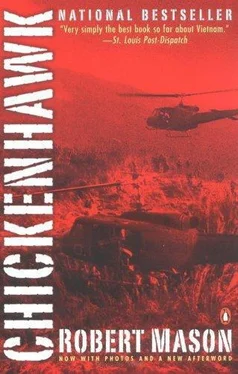Anderson very carefully demonstrated the flight school’s procedure for getting into and out of confined areas. It was a method designed to minimize damage. A student helicopter pilot wallowing around in a hover in a tight clearing is an accident waiting to happen. You circled the clearing you picked until you had determined the best approach path over the lowest obstacles, into the wind. You would then pick a spot in the clearing and make your landing. On the ground, you would lock the collective down and the throttle at idle position and get out of the helicopter, leaving it running. You put a rock or a stick under the chin bubble so you could see it from inside. Then you went to the downwind side of the clearing, paced a distance equal to the length of the helicopter plus five paces safety margin back from the nearest obstacle, and deposited another marker. Then you paced it out to see if you were able to turn around in a hover over the first marker without hitting the trees at the upwind side of the clearing. If you could, you were finished analyzing the area and could get back into the machine. If you couldn’t turn it and were going to have to hover backward from the upwind marker to the downwind marker, you had to install a line of markers between the two points as a guide for your rearward flight.
Each clearing was different. Some required much pacing and marking to get out of. Others were so big and free of obstacles that the drill of placing markers seemed pointless. Months later, in Vietnam, I realized that I automatically analyzed each clearing before I landed. The drill worked.
Anderson sometimes took two of his students on a demonstration ride, to save time. One day we landed in a very small, confined area marked with a red tire, signifying that it was to be used only with an IP. Hovering at the front of the clearing, the tail rotor was only a few feet from the rear. Anderson backed the helicopter a few feet and tried to take off. Several factors were against us. One, it was a very hot day, making the density altitude very high, giving us less than normal lift. (Air density is corrected for altitude, temperature, and humidity. Hot, humid air raises the density altitude; cold, dry air lowers it.) Two, the machine was overloaded for this density altitude. (This was a common flying condition in Vietnam.) Anderson made one attempt to get over the trees in front of us and had to abort the takeoff midway, sliding backward into the clearing. The ship would not go. I offered to get out and walk to a nearby field.
“Not necessary,” said Anderson. He picked up to a hover and began to circle around in the tiny clearing, just missing the trees with the rotors. My classmate and I thought he had gone nuts. But after two tight turns we could see what he was trying to do. He was accelerating in a circle to translational-lift speed. When the ship lurched into translational lift, Anderson aimed for the gap between two trees and went. He made it. It was a much tighter fit than a student would be allowed to try, but he made it. I never forgot that takeoff. There is always a way.
A few days later I ended my five months at Fort Wolters with an hour-long, sweaty check ride in which I successfully demonstrated my abilities to the army inspector. Our class was to continue the course at Fort Rucker.
We arrived with eighty-five hours of flight time from Wolters. We logged eighty-eight more in the H-19 Sikorsky, learning to do confined areas without markers, landing on pinnacles, and doing lots of cross-country and tactical flying. During the last month we would log twenty-seven hours in the ship everybody lusted to fly: the Bell HU-1 Iroquois, known as the Huey. Huey time was divided between ten hours of orientation and seventeen hours of instrument flying.
Though the flight training progressed noticeably, our status did not. We had become senior candidates at Wolters, only to begin over again as junior classmen at Rucker. It wasn’t a complete regression, though. Married students were allowed to live off base with their wives.
The two trainers we flew at Rucker occupied two poles in the technological developent of helicopters. The H-19 Sikorsky, which looked like a giant tadpole with four wheels, was so tall there were built-in steps leading from the ground to the cockpit. The monster was powered by a heavy, thirteen-cylinder radial engine that took up a large percentage of its potential cargo capacity. The ten seats in its hold, filled with passengers, rendered the machine unhoverable on most days. It had to make running takeoffs even with moderate loads.
The Huey, on the other hand, with its powerful, lightweight engine, had power to spare. It could hover and take off with ten passengers and a crew of two. It was also quiet, started easily on cold mornings, and was simpler to maintain. Flying the two ships was a telescoped course in the development of helicopters.
For all its drawbacks, the H-19 was still a good trainer. The H-23 had had direct mechanical linkages to control the rotor system and required heavy-handed operation. The H-19 had hydraulic controls which required a light touch. Its sensitive controls, coupled with its under-powered bulk, made it fly like an overloaded Huey.
We expected to jump into the new trainer and show our new IPs we were pilots. On my first try, as happened to everybody else, the H-19 just sank to the ground when the IP let me have the controls.
“The reason you’re sinking is because you’re moving the cyclic too much. That dumps the air cushion from under the disk. Use pressure. If you can see the controls move, that’s too much. If nothing else, flying this machine will teach you subtlety on the controls.”
And so it did. In a few hours I didn’t think about the control response at all. I even enjoyed flying the monster.
The last twenty hours or so in the H-19 were spent in the field, simulating air assaults in student aviation companies. We flew reconnaissance missions, day and night cross-country, and were given turns at planning and leading air assaults composed of many ships flying in loose formation.
Near the end of our training with the H-19 we began to see more and more of the Huey in our ground-school classes.
“The Huey is the army’s latest utility helicopter,” said the narrator of a training film. A Huey flying low level filled the screen. The camera zoomed in to the main rotor hub spinning above the engine nacelle. “The T53-L-11 gas-turbine engine develops eleven hundred horsepower yet weighs only five hundred pounds. The turbine is basically a jet engine with a fan placed in the exhaust.” An animation showed an engine cutaway. A twelve-inch-diameter turbine fan spun in the gases behind a jet engine. “This single turbine fan is connected by a shaft running back through the engine to the transmission. The pressure of the gases pushing through this fan generates sufficient force to turn the forty-eight-foot rotor system and the eight-foot tail-rotor assembly and lift the 5000-pound machine plus a maximum load of 4500 pounds into the air.” The animation dissolved to a Huey banking away to swoop down to a jungle. “The Huey’s streamlined design allows a maximum cruise speed of 120 knots.” We laughed at this point, because our H-19s flew at 80 knots. The film showed a Huey sitting in a clearing. As the announcer spoke, the craft began to rise vertically. “Though not recommended, the Huey is capable of hovering vertically up to an altitude of 10,000 feet on a standard day.” The film went on to show how it was variously configured as an air ambulance (Medevac) carrying six litters; as a gunship (Guns) carrying pilot-directed machine guns, rockets, or grenade launchers; and as a troop carrier (Slick) with room for ten soldiers and two crew-operated door guns.
My first impression of the machine was that it was pure silk. When the IP squeezed the starter trigger on the collective, the response was a shrill whine as the highspeed starter motor began slowly to move the blades, not the clacking cough and roar I was used to. At operating speed there was no roaring, vibrating, or shaking, just a smooth whine from the turbine. The IP signaled me to pull up the collective. The big rotors thudded a little as they increased their pitch, and the machine left the ground like it was falling up.
Читать дальше












